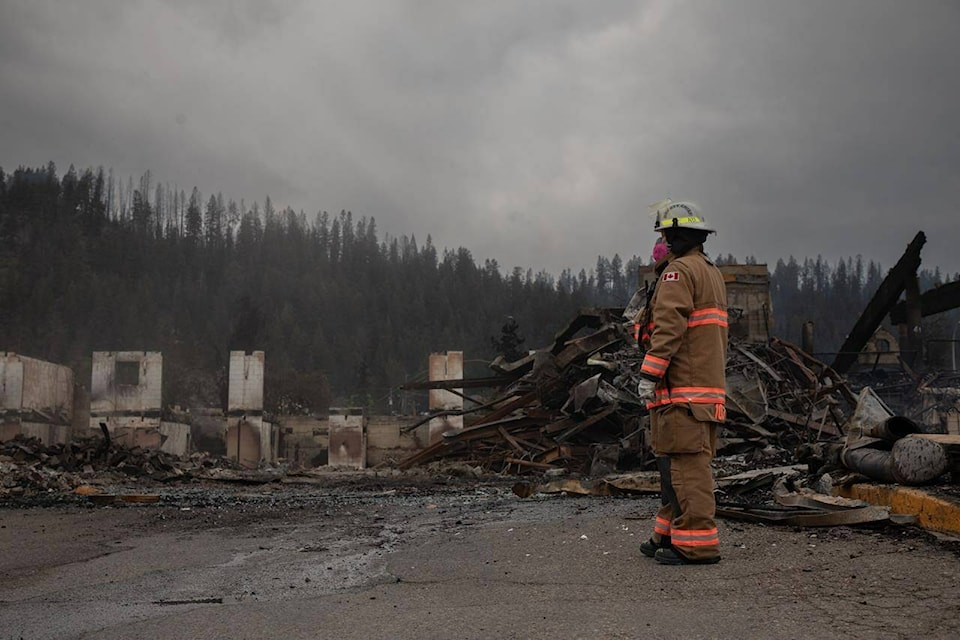Jasper, Alberta is the latest community to experience catastrophic wildfire. After consuming a swath of Jasper National Park, the blaze advanced five kilometers to the town of Jasper in a half hour. The “wall of fire,” reported at 300 to 400 feet in height, then swept into town, obliterating one third of the structures, mostly residences. Perhaps 40 percent of residents have lost their homes.
Climate change is not going to go away. Wildfires will only increase in quantity and severity in the future. It is folly for governments to continue to manage forests as they have over the last century. That management has contributed to catastrophic fire becoming normal.
In 2003, the Okanagan Mountain wildfire, often referred to as a firestorm, burned over 250 square miles. It destroyed nearly 240 homes. In a pyrocumulonimbus firestorm, ample fuel, heat and wind produce a fire so large and intense that it creates its own weather. Storm-force winds blow in from all sides to the center. The huge updraft of hot air at the center can produce a thunderstorm.
In 2021, the most notable firestorm was in Lytton. The town was virtually eradicated. Residents had just minutes to escape. Micheal Fromm, a meteorologist with the U.S. Naval Research Laboratory, at the time, said, “It was probably the single largest pyrocumulonimbus storm of the year so far.”
In 2023, the McDougall Creek Fire destroyed nearly 200 homes, most on the west side of Okanagan Lake. Amazingly, burning embers crossed the lake and caused fires in Kelowna. 2023 was the most destructive fire season on record in both B.C. and Canada.
Catastrophic wildfires have occurred in years past in Alberta too. The 2016 Fort McMurray wildfire forced the evacuation of 90,000 people. It destroyed 2400 structures and led to the largest insured loss in Canadian history – $3.7 billion. The fire consumed a staggering 5890 square kilometers.
Wildland areas, prior to the early 20th century, featured a variety of forest and non-forest landscapes and numerous tree species. Forest management policies, beginning in the early 1900s, prioritized fire suppression to preserve valuable timber and reforestation with the most commercially valuable species, which were coniferous, particularly pine.
As these policies took hold, dead wood accumulated in forests, and forests became denser, more expansive, more homogeneous and more susceptible to severe fire. Fire resistant deciduous species became less prevalent. Grasslands, which serve as natural fire breaks, disappeared. All of this, along with intensified drought and heat, has created ideal conditions for catastrophic fires.
The disastrous fire at Jasper demonstrates the impact of past and present forest management. The 2018 Jasper National Park Annual Report stated, “Area burned is [rated] poor as the fire deficit in the park has accumulated over the past century in most habitat types.” The area exposed to natural fire or burn treatments, in plain words, was completely insufficient to prevent fuel accumulation.
Parks Canada has managed fuel loads better than provincial governments, but that is faint praise. Columnist, Jamie Sarkonak, wrote that 2022 Parks Canada reports rated the various habitats in the park as much as 88% below the historic burn levels. Sarkonak concluded, “It was a tinderbox.”
Notably, wildfire ecologist Robert Gray told the CBC that historic photos show the park wasn’t always densely covered with Conifers. He added, “And now we have this just large buffet out there, which is just what fire needs.”
The risk of catastrophic wildfire is greatly amplified by the outdated, harmful forest practices currently in use. Governments remain intent on suppressing fire, after it has started. Government funding of fuel reduction and other prudent forest practices is minimal. Serious forestry reform is absent from government agendas.
B.C.’s Forest Practices Board recommends “landscape forest management,” to provide protection against aggressive wildfire. Tools available include prescribed burns, removal or chipping of dead wood, thinning of forests and restoration of heterogeneous landscapes and varied tree species.
As climate change ramps up, Alberta and B.C. are particularly vulnerable to wildfire, but the other provinces and territories are at risk as well. The recent Jasper fire will not be the last catastrophic wildfire in Alberta or B.C. Rather, without extensive reform, Jasper is the first of many catastrophic wildfires that will befall Canada’s west in 2024 and beyond.
A column by Bruce Uzelman
Bruce Uzelman, based in Kelowna, holds interests in British Columbia history as wells as current political and economic issues.
Bruce had a career in small business, primarily restaurant and retail. He holds a Bachelor of Arts, Advanced from the University of Saskatchewan, with Majors in Political Science and Economics.
Contact: urban.general@outlook.com



